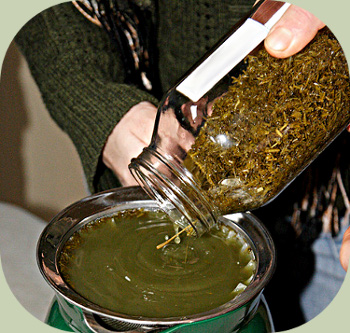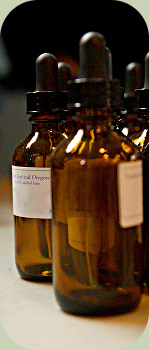Tincture Recipes:
Making Home Remedies

Looking for some great tincture recipes to help you heal and stay healthy?
For starters, tincture is typically an alcoholic extract of plants for use as medicine. The alcohol acts as a solvent, extracting primarily the medicinal components such as alkaloids, glycosides, minerals, and essential oils. Other solvents can be used in place of alcohol, such as vinegar or glycerin, though they are typically less effective at extracting medicinal constituents of plants.
Most alcohols consist of a percentage of pure alcohol (ethanol) while the rest is water. The alcohol extracts substances that water cannot extract and vice-versa. Therefore, it is often important to know what percentages of alcohol/water is necessary for the particular plant and medicinal properties you wish to extract.
A few important notes in making any tincture:
- Make sure that you only use plants that are non-toxic and safe for human use.
- If you do not know the plants you are working with, research them thoroughly before hand.
- Use only alcohol made for human consumption as your tincture base. Clear vodkas are one of the easiest forms to use for tincture base. Ideally, acquire a grain alcohol that is 95% alcohol (190 proof) and dilute it as necessary.
- Make sure that the alcohol covers the plant material fully. Do not leave any plant material exposed to the air.
- Tinctures are meant to be used as medicine in small amounts. Once made, put them into small dropper bottles and add a little bit to your tea, juice, water or directly into your mouth when needed.
- For most tincture recipes, you will want to let your tincture sit for about two weeks. Then you will need to strain it and pour it into your preferred containers.
Tincture Recipes: Burdock Root
Burdock (Arctium spp.) is known as both an edible root and a useful medicine that assists liver function, digestion, and skin health. It is high in iron and a vast array of other minerals.
Burdock tincture is typically made from either the fresh or dried roots. Here is what you need to do:
- Clean and cut up several fresh roots.
- Put them in a clean container (preferably glass)
- Use a vodka that has 50% alcohol content (also known as 100 proof)
- Add the alcohol at a 2:1 ratio (i.e. 2 cups of vodka to 1 cup of fresh roots)
- If you are using dried roots, use a 5 to 1 ratio instead (i.e. 5 cups of vodka to 1 cup of dried roots)
Be More Prepared For Your Next Outdoor Adventure!

Don't leave home without knowing these six essential survival skills. Our free survival mini guide reveals the strategies of:
- Shelter & fire to prevent the number one cause of death
- Obtaining clean water to avoid life-threatening dehydration
- Common wild survival foods and other critical skills!

Tincture Recipes: Dandelion Tincture
Like burdock, dandelion (Taraxacum officinalis) is both an edible and medicinal plant. Dandelion is rich in protein, potassium, inulin, iron and trace minerals.
You can use the fresh or dried leaves and roots.
- Clean and cut up several fresh roots and/or leaves
- Put them in a clean container
- Use a vodka that has 45% alcohol content (also known as 90 proof)
- Add the alcohol at a 2:1 ratio (i.e. 2 cups of vodka to 1 cup of fresh leaves/roots)
- If you are using dried leaves/roots, use a 5 to 1 ratio instead (i.e. 5 cups of vodka to 1 cup of dried leaves/roots)

Tincture Recipes: Stinging Nettle
Although stinging nettle is known to many mainly for its itchy stings, it is an amazing medicinal and edible plant. Nettles are rich in iron, potassium, calcium, manganese, and trace minerals.
- Cut fresh or shred dried plants
- Put them in a clean container
- Use a vodka that has 50% alcohol content (also known as 100 proof)
- Add the alcohol at a 2:1 ratio (i.e. 2 cups of vodka to 1 cup of plant materials)
There is a wide variety of tincture recipes out there. Just about any medicinal plant can be made into a tincture. Whether to maintain or boost health, tinctures are a simple and accessible way to get started making your own at home medicines.
By the way, when you're out foraging, it's important to know how to stay safe in the outdoors, especially if you were to get lost. Right now you can get a free copy of our mini survival guide here, where you'll discover six key strategies for outdoor emergencies, plus often-overlooked survival tips.
Additional Resources:
How to Make Herbal Tinctures - Wellness Mama
Related Courses:
For detailed information and hands-on training with wild medicinal plants check out our Wild Edible & Medicinal Plants Courses.

About the Author: Filip Tkaczyk is a periodic guest teacher at Alderleaf. He also wrote the field guide Tracks & Sign of Reptiles & Amphibians. Learn more about Filip Tkaczyk.
Return from Tincture Recipes back to Edible & Medicinal Plants Articles
Is The Essential Wilderness Survival Skills Course Right for You? Take the "Online Survival Training Readiness" Quiz
See for yourself if this eye-opening course is a good fit for you. It takes just a few minutes! Get your Survival Training Readiness Score Now!

Grow Your Outdoor Skills! Get monthly updates on new wilderness skills, upcoming courses, and special opportunities. Join the free Alderleaf eNews and as a welcome gift you'll get a copy of our Mini Survival Guide.

 The Six Keys to Survival: Get a free copy of our survival mini-guide and monthly tips!
The Six Keys to Survival: Get a free copy of our survival mini-guide and monthly tips!
Learn more